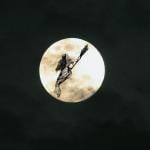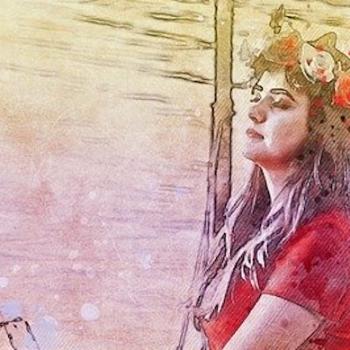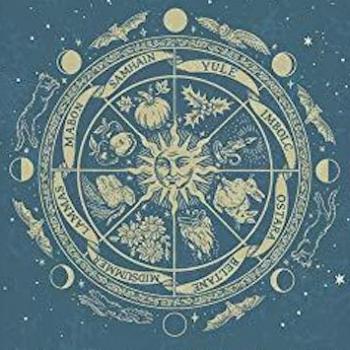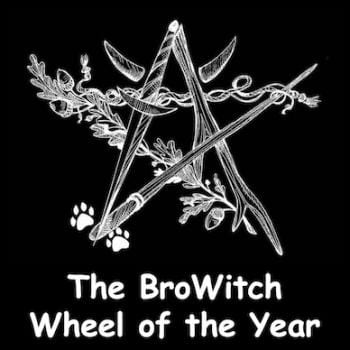It’s Lammas time, and I see lots of posts on social media about bread and harvests, but there’s always a bit of a disconnect for many of us. I might try to bake some bread for the holiday, and my garden is showing signs of life;there are tomatoes on the vine, sunflowers approaching six feet tall, and I’ve got a few small pumpkins the size of at least softballs. I’ve even got a couple of green beans ready for harvest (but not enough for even much of a side dish), but I still can’t say I’m excited about Lughnasadh.

Without question, things are happening right now, and it feels like Lammas-season, but Lughnasadh has long been the least-popular of the “greater” or “cross-quarter” sabbats. If online readership is an indication of how we feel about the sabbats (and I think it is), the numbers show that Lughnasadh is not all that appreciated in the greater world. Over on John Beckett’s Under the Ancient Oaks, Lughnasadh ranks as the least popular sabbat. Things aren’t quite so dire at Patheos Pagan as a whole, but Lammas still ranks in the bottom rung.
Sabbats are not a popularity contest, but it’s fascinating to notice what resonates with us and what doesn’t. When Lughnasadh’s also-ran status comes up you’ll often see people attributing it to people “living in urban areas” and “being out of touch with nature,” and while that might sort of be true, I don’t think it really holds much water. Modern Paganism first thrived in urban areas, and the Pagan impulses of the early 19th Century began in those spaces. People are well aware of their disconnect, Paganism exists to fill in those disconnects.

In a similar vein, I sometimes hear “we aren’t close to the grain fields anymore” as a reason for Lammas’s lack of popularity. Again, Paganism grew up in the city, and it was hard to spot a grain field from London in 1954 or even 1854. Besides, equating Lammas simply with bread is pretty lazy. Lammas is a harvest festival, no matter where we live there’s the potential to harvest something in early August. Given how much Witches especially love Samhain, you’d think that the first harvest festival we’d be a cause for real celebration, isn’t it the first indication of Autumn?
There are a few mundane factors that should be considered when writing about Lammas. In many places it’s ungodly hot, it’s hard to get excited for every much when the weather is like that. Despite the excitement often attached to the word “summer,” the Summer doldrums are a real thing. In normal times, early August is also a time for vacations and the like for some people. It’s hard to celebrate Lughnasadh in a hotel room. But many of those caveats also apply to other sabbats in some way. It’s ungodly cold at Imbolc for instance and it’s also a time for the Winter blues, and people often travel at Yule. Lammas’s lack of popularity involves more than just mundane concerns.
I think there are reasons far beyond disconnect and mundania for the shrug that generally greats Lughnasadh. And I know that some of you are out there reading this yelling at your phones that Lughnasadh is your favorite holiday. We all get that, it has to be someone’s favorite holiday. I’m sure there are people out there who love Arbor Day passionately too. Beyond the usual explanation here are some reasons why Lughnasadh isn’t as popular as some of the other sabbats.
Stories To Tell
Most sabbats revolve around stories, some supported by history, others less so, but they are all stories none the less. Think about Yule for a moment, there are dozens of stories to tell at Midwinter every year. There are gift-givers like Santa Claus, and deterrents against bad behavior like the Krampus. The Oak King and Holly King fight for supremacy on the solstice, and hundreds of thousands of Pagans stay up all night long to witness the sun’s rebirth. There are traditions like wassailing, and evergreen trees grace living rooms across the world.
At Samhain we carve pumpkins and place them on our porches while we wait for the Veil Between the Worlds to drift away and offer us reunion with our beloved dead for just a moment. We celebrate the freedom to be a Witch without most of the awkward glances, and we call upon Persephone while eating pomegranate seeds. Samhain-season has long been a time for divination as well, and many Witches celebrate it as the start of the Wheel’s next turn.

Do you see what I’m getting at here? STORIES! So many of the sabbats have stories upon stories, Lammas has bread? We don’t decorate our houses for Lammas or argue about whether or not the Lughnasadh Llama is a traditional Pagan figure. Some of us make corn dollies, or maybe prepare for their first visit from the Cailleach, but that’s two stories, and doesn’t quite compare to the thousands of stories we can tell at Ostara and Beltane.
I’m sure the lack of traditions at Lammas is tied into the intense amount of work that occupied (and occupies) those in agricultural settings. Yule, and even Samhain, were times of less labor. Lammas was a time of even more labor. It’s hard to tell a story when you’ve been working for 14 straight hours to bring the harvest in. Because of this the stories that developed around the other cross-quarter days are largely absent from Lammas.
Lugh Is Not Sexy
I mean no disrespect to Lugh, who was a god of many skills, and a fine figure to honor at Lughnasadh. Heck, his name is even in Lughnasadh, making him one of only three deities explicitly tied to a sabbat (the other ones being Brigid at Imbolc and Eostre at Ostara), but that doesn’t make him sexy. There are no blogs dedicated strictly to Lugh, and I can’t help but wonder if Lughnasadh would be more popular if it were called Hekatesadh. (Also in the running there was Morrigansadh.)
(There’s also Mabon of course, which might be a fourth sabbat named after a deity, but have you ever been to a ritual where Mabon is celebrated at the Autumn Equinox? I haven’t either.)

Perhaps if there were an ancient agricultural celebration focused on Demeter in early August Lughnasadh would be more popular, but there’s just not. It’s weird to me, that despite the name Lugh being in Lughnasadh, he doesn’t figure in very many rituals. I realize as I write that whatever John Beckett’s up to is a big exception, but I feel like I’m more likely to run into a John Barleycorn ritual in August than I am one focused on Lugh.
It probably doesn’t help that Lugh, despite his many skills, isn’t explicitly tied into many of the more common Lughnasadh tropes. Perhaps if Lugh were a sacrificial-agricultural deity his holiday would be more popular? Or what if Lugh was called Lugh the Baker and was well known for his delicious croissants, loaves, and scones? I’m having fun here, but when I’m done writing this I’m going to go poor a solid libation just to stay in his good graces.
The Over-Culture
This is the big one, and while many Pagans protest when you mention that they might like Samhain and Yule more than the others because those sabbats are directly reflected in the over-culture’s Halloween and Christmas, it’s still most likely true. On my last trip to the grocery store the front doors weren’t decorated with pictures of bread and ripe fields of grain. Instead there was no mention of anything seasonal at all. If there are any signs up right now other than “wear a mask!” they are generally related to “back to school.”

The sabbats simply feel bigger and more important when it seems like everyone else is celebrating them. Ostara, which doesn’t have any sort of ancient pedigree, is wildly popular, often more so than Beltane, especially in the United States. This is no doubt due to its proximity to the Christian Easter both on the calendar and linguistically. It sucks that Christianity has such a big impact no our holidays, but it does!
And I know some of you are going “well Lammas became a Catholic holiday,” but I think it’s safe to say that “nobody cares,” because they don’t. Groundhog Day is a bigger deal. I’ve never turned on the news to find a story about how people were celebrating Lammas today, yesteryear, or hundreds or thousands of years ago. It’s just not on our radar.
None of this means that Lammas/Lughnasadh isn’t worth celebrating, it most certainly is! There are lots of cool traditions having to do with time of year out there. But for the reasons mentioned here it’s most likely that it will continue to be one of the “ugly ducklings” on the wheel of the year.

















